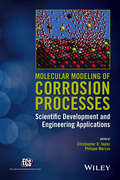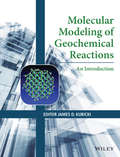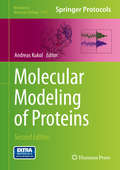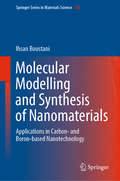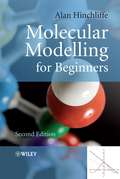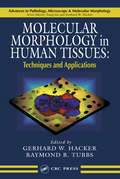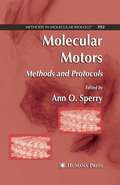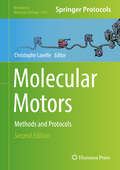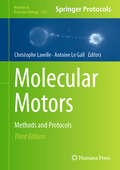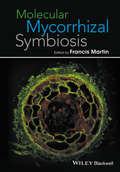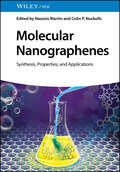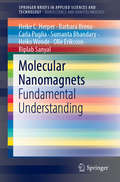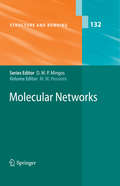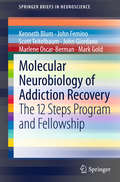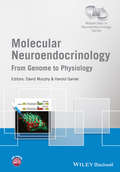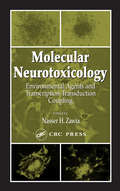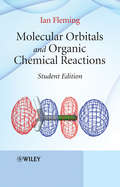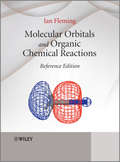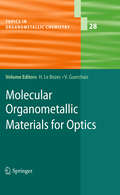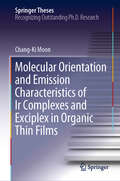- Table View
- List View
Molecular Modeling of Corrosion Processes
by Philippe Marcus Christopher D. TaylorPresents opportunities for making significant improvements in preventing harmful effects that can be caused by corrosion Describes concepts of molecular modeling in the context of materials corrosion Includes recent examples of applications of molecular modeling to corrosion phenomena throughout the text Details how molecular modeling can give insights into the multitude of interconnected and complex processes that comprise the corrosion of metals Covered applications include diffusion and electron transfer at metal/electrolyte interfaces, Monte Carlo simulations of corrosion, corrosion inhibition, interrogating surface chemistry, and properties of passive films Presents current challenges and likely developments in this field for the future
Molecular Modeling of Geochemical Reactions: An Introduction
by James D. KubickiMolecular processes in nature affect human health, the availability of resources and the Earth's climate. Molecular modelling is a powerful and versatile toolbox that complements experimental data and provides insights where direct observation is not currently possible. Molecular Modeling of Geochemical Reactions: An Introduction applies computational chemistry to geochemical problems. Chapters focus on geochemical applications in aqueous, petroleum, organic, environmental, bio- and isotope geochemistry, covering the fundamental theory, practical guidance on applying techniques, and extensive literature reviews in numerous geochemical sub-disciplines. Topics covered include:* Theory and Methods of Computational Chemistry* Force Field Application and Development * Computational Spectroscopy * Thermodynamics* Structure Determination * Geochemical Kinetics This book will be of interest to graduate students and researchers looking to understand geochemical processes on a molecular level. Novice practitioners of molecular modelling, experienced computational chemists, and experimentalists seeking to understand this field will all find information and knowledge of use in their research.
Molecular Modeling of Proteins
by Andreas KukolMolecular modeling has undergone a remarkable transformation in the last 20 years. This book provides thorough introductions and a compilation of step-by-step methods applicable to problems faced by non-specialists - especially those new to the software packages used in molecular modeling. Tips on troubleshooting and avoiding common pitfalls are included in the book, along with chapters covering a wide range of subjects. Links to downloadable software are also provided.
Molecular Modelling and Synthesis of Nanomaterials: Applications in Carbon- and Boron-based Nanotechnology (Springer Series in Materials Science #290)
by Ihsan BoustaniThis book presents nanomaterials as predicted by computational modelling and numerical simulation tools, and confirmed by modern experimental techniques. It begins by summarizing basic theoretical methods, then giving both a theoretical and experimental treatment of how alkali metal clusters develop into nanostructures, as influenced by the cluster's "magic number" of atoms. The book continues with a discussion of atomic clusters and nanostructures, focusing primarily on boron and carbon, exploring, in detail, the one-, two-, and three-dimensional structures of boron and carbon, and describing their myriad potential applications in nanotechnology, from nanocoating and nanosensing to nanobatteries with high borophene capacity. The broad discussion of computational modelling as well as the specific applications to boron and carbon, make this book an essential reference resource for materials scientists in this field of research.
Molecular Modelling for Beginners
by Alan HinchliffeA concise, basic introduction to modelling and computational chemistry which focuses on the essentials, including MM, MC, and MD, along with a chapter devoted to QSAR and Discovery Chemistry.Includes supporting website featuring background information, full colour illustrations, questions and answers tied into the text,Visual Basic packages and many realistic examples with solutionsTakes a hands-on approach, using state of the art software packages G03/W and/or Hyperchem, Gaussian .gjf files and sample outputs.Revised with changes in emphasis and presentation to appeal to the modern student.
Molecular Morphology in Human Tissues: Techniques and Applications (Advances in Pathology, Microscopy, & Molecular Morphology)
by Gerhard W. Hacker Raymond R. TubbsMolecular Morphology in Human Tissues: Techniques and Applications presents the most advanced molecular morphological techniques to date. This integrated approach to molecular morphology provides powerful analytical and diagnostic tools at the genome level, making the diagnosis and management of cancer, viral infections, and other diseases more pre
Molecular Motors
by Ann O. SperryMolecular motor proteins produce force for movement in an incredibly wide variety of cellular processes. This volume explores the extreme functional and structural diversity of molecular motors and presents methods relevant to each motor family. In addition, it describes techniques directed at motors that fall outside of the three characterized families: dynamin and F1ATPase.
Molecular Motors: Methods and Protocols (Methods in Molecular Biology #1805)
by Christophe LavelleThis volume expands on the previous edition with a more extensive look at molecular motors and their roles in muscle contractions, vesicle transport, flagellar beating, chromosome segregation, and DNA replication and repair. The chapters in this book are divided into three parts: Part One looks at membrane motors, such as the bacterial flagellar rotary motor; Part Two discusses cytoskeletal motors, such as kinesin and myosin; and Part Three talks about nucleic acid motors, such as DNA polymerases, helicases, and nucleosome remodelers. Written in the highly successful Methods in Molecular Biology series format, chapters include introductions to their respective topics, lists of the necessary materials and reagents, step-by-step, readily reproducible laboratory protocols, and tips on troubleshooting and avoiding known pitfalls.Cutting-edge and comprehensive, Molecular Motors: Methods and Protocols, Second Edition is a valuable resource for (bio)physicists and molecular/cellular biologists whose research delves into the mechanisms at work in cells and the motors which power them.
Molecular Motors: Methods and Protocols (Methods in Molecular Biology #2881)
by Christophe Lavelle Antoine Le GallThis fully updated volume presents a diverse collection of protocols and methodologies for studying various molecular motors. The book explores the dynamics of the bacterial flagellar motor, the mechanisms of ATP synthase, the assembly and function of cytoskeletal motors, and the role of nucleic acid motors in cellular processes, while placing a strong emphasis on state-of-the-art techniques, highlighting innovative methods such as single-molecule visualization and high-resolution tracking, sophisticated biochemical assays, bioengineering applications, as well as computational modeling. Written for the highly successful Methods in Molecular Biology series, chapters include introductions to their respective topics, lists of the necessary materials and reagents, step-by-step and readily reproducible laboratory protocols, and tips on troubleshooting and avoiding known pitfalls. Authoritative and practical, Molecular Motors: Methods and Protocols, Third Edition serves as an ideal guide to enable researchers to probe the mechanisms of molecular motors with unprecedented precision and detail.
Molecular Mycorrhizal Symbiosis
by Francis MartinRecent years have seen extensive research in the molecular underpinnings of symbiotic plant-fungal interactions. Molecular Mycorrhizal Symbiosis is a timely collection of work that will bridge the gap between molecular biology, fungal genomics, and ecology. A more profound understanding of mycorrhizal symbiosis will have broad-ranging impacts on the fields of plant biology, mycology, crop science, and ecology. Molecular Mycorrhizal Symbiosis will open with introductory chapters on the biology, structure and phylogeny of the major types of mycorrhizal symbioses. Chapters then review different molecular mechanisms driving the development and functioning of mycorrhizal systems and molecular analysis of mycorrhizal populations and communities. The book closes with chapters that provide an overall synthesis of field and provide perspectives for future research. Authoritative and timely, Molecular Mycorrhizal Symbiosis, will be an essential reference from those working in plant and fungal biology.
Molecular Nanographenes: Synthesis, Properties, and Applications
by Nazario Martín Colin P. NuckollsExplore the world’s most powerful materials with nanographene research Graphene, comprised of a single layer of carbon atoms in a honeycomb nanostructural arrangement, is the thinnest and strongest material yet known to science. Despite that this pristine carbon allotrope exhibits a variety of outstanding properties, its zero bandgap prevents its use for some optoelectronic applications. Fragments of graphene, or nanographenes, have shown a great potential to obviate these problems, thus paving the way for the development of chiroptical and optoelectronic properties. Molecular Nanographenes constitutes a comprehensive overview on the synthesis of these materials and their properties. Covering their widely varying morphologies, their potential applications, and their valuable chiroptical and photophysical features, it also analyzes multiple approaches to obtain nanographene by using both top-down and bottom-up methodologies. The result is a one-stop shop for materials scientists and other researchers interested in these emergent and fascinating materials. Molecular Nanographenes readers will also find: A careful distinction between top-down and bottom-up approaches to nanographene synthesisDetailed discussion of nanographene configurations including planar, bilayer, helical, nanobelt, and many other geometries An authorial team with pioneering research experience in the study of nano-sized graphenes and their synthesis Molecular Nanographenes is ideal for materials scientists, polymer chemists, solid state chemists, organic chemists, and any other researchers looking to work with shape and size-controlled flakes of graphenes.
Molecular Nanomagnets: Fundamental Understanding (SpringerBriefs in Applied Sciences and Technology)
by Heike C. Herper Barbara Brena Carla Puglia Sumanta Bhandary Heiko Wende Olle Eriksson Biplab SanyalThis book focuses on 3d transition metal centered phthalocyanine molecules and their deposition on different substrates. Phthalocyanines are an ideal prototype since they can be grown flat on many surfaces. It highlights the molecule-substrate interaction and its influence on the magnetic and spectroscopic properties of the molecules as well as the influence of ligands — reviewing both experiential and theoretical data. Since experimental setups differ and approximations in theory vary and can influence the result, a substantial part is dedicated to a thorough discussion of the different experimental and computational methods from the point of view of reliability and predictive power.
Molecular Networking: Statistical Mechanics in the Age of AI and Machine Learning
by Caroline Desgranges Jerome DelhommelleThe book builds on the analogy between social groups and assemblies of molecules to introduce the concepts of statistical mechanics, machine learning and data science. Applying a data analytics approach to molecular systems, we show how individual (molecular) features and interactions between molecules, or "communication" processes, allow for the prediction of properties and collective behavior of molecular systems - just as polling and social networking shed light on the behavior of social groups. Applications to systems at the cutting-edge of research for biological, environmental, and energy applications are also presented.Key features: Draws on a data analytics approach of molecular systems Covers hot topics such as artificial intelligence and machine learning of molecular trends Contains applications to systems at the cutting-edge of research for biological, environmental and energy applications Discusses molecular simulation and links with other important, emerging techniques and trends in computational sciences and society Authors have a well-established track record and reputation in the field
Molecular Networks
by Mir Wais HosseiniFrom the reviews: “This book gives an overview of some recent developments in crystal engineering of molecular and metalloorganic solids in five, essentially independent chapters written by different authors. … All in all, this book makes good reading material that can appeal to nonexperts by showcasing some recent developments in the field of crystal engineering, as well as to … experts seeking a detailed overview of a specific subfield, such as a comprehensive account of all possible assemblies of bipyridine-dioxide … .” (Dmitrii F. Perepichka, Journal of the American Chemical Society, Vol. 132 (11), 2010)
Molecular Neurobiology of Addiction Recovery
by Kenneth Blum Marlene Oscar-Berman John Femino John Giordano Mark Gold Scott TeitelbaumHumans are biologically programmed to seek out pleasurable experiences. These experiences are processed in the mesolimbic system, also referred to as the "reward center" of the brain, where a number of chemical messengers work in concert to provide a net release of dopamine in the Nucleus Accumbens. In some genetically predisposed individuals, addiction occurs when the mechanisms of the mesolimbic system are disrupted by the use of various drugs of abuse. Since Alcoholics Anonymous was founded in 1935, it's 12 step program of spiritual and character development has helped countless alcoholics and drug addicts curb their self-destructive behaviors. However, the program was developed at a time when comparatively little was known about the function of the brain and it has never been studied scientifically. This is the first book to take a systematic look at the molecular neurobiology associated with each of the 12 steps and to review the significant body of addiction research literature that is pertinent to the program.
Molecular Neuroendocrinololgy
by David Murphy Harold GainerMolecular Neuroendocrinology: From Genome to Physiology, provides researchers and students with a critical examination of the steps being taken to decipher genome complexity in the context of the expression, regulation and physiological functions of genes in neuroendocrine systems. The 19 chapters are divided into four sectors: A) describes and explores the genome, its evolution, expression and the mechanisms that contribute to protein, and hence biological, diversity. B) discusses the mechanisms that enhance peptide and protein diversity beyond what is encoded in the genome through post-translational modification. C) considers the molecular tools that today's neuroendocrinologists can use to study the regulation and function of neuroendocrine genes within the context of the intact organism. D) presents a range of case studies that exemplify the state-of-the-art application of genomic technologies in physiological and behavioural experiments that seek to better understand complex biological processes. * Written by a team of internationally renowned researchers* Both print and enhanced e-book versions are available* Illustrated in full colour throughout This is the third volume in a new Series 'Masterclass in Neuroendocrinology' , a co- publication between Wiley and the INF (International Neuroendocrine Federation) that aims to illustrate highest standards and encourage the use of the latest technologies in basic and clinical research and hopes to provide inspiration for further exploration into the exciting field of neuroendocrinology. Series Editors: John A. Russell, University of Edinburgh, UK and William E. Armstrong, The University of Tennessee, USA
Molecular Neuroscience
by Alan Longstaff Dr P RevestThis book provides insights into general experimental strategies and quite detailed accounts of experiments in molecular neuroscience. It is useful to final year undergraduates and post-graduates interested in the impact that the new science of molecular biology is having on neuroscience.
Molecular Neurotoxicology: Environmental Agents and Transcription-Transduction Coupling
by Nasser H. ZawiaMolecular Neurotoxicology: Environmental Agents and Transcription-Transduction Coupling deals with changes in gene expression following exposure to neurotoxicants, as well as deciphering signal transduction or transcription coupling that is altered by the same exposure. Until now, little has been published on the topic in one reference, and toxicol
Molecular Oncology
by Edward P. Gelmann Charles L. Sawyers Frank J. Rauscher III Edward P. Gelmann Charles L. SawyersThe genomic era has allowed enormous strides in our understanding of the molecular changes that underlie malignant transformation. Mutations have been discovered that are critical drivers of large cross-sections of human cancers. These discoveries have allowed us to find drugs that target these drivers and make important strides in treatment. Genomics and high-throughput technologies have illuminated the complexity of cancer and the facility with which cancers adapt during their natural history. The field is evolving rapidly with new discoveries and new drugs reported monthly. This book is a timely foundation for understanding in context the origins of molecular oncology and its future directions. The content reviews available technologies for the analysis of cancer tissues and genes; summaries of key oncogenic pathways from a molecular perspective; the technologies, pathways and targeted therapies of a wide range of human malignancies; and new pharmacologic therapies that have a common mechanistic target.
Molecular Orbitals and Organic Chemical Reactions
by Ian FlemingWinner of the PROSE Award for Chemistry & Physics 2010Acknowledging the very best in professional and scholarly publishing, the annual PROSE Awards recognise publishers' and authors' commitment to pioneering works of research and for contributing to the conception, production, and design of landmark works in their fields. Judged by peer publishers, librarians, and medical professionals, Wiley are pleased to congratulate Professor Ian Fleming, winner of the PROSE Award in Chemistry and Physics for Molecular Orbitals and Organic Chemical Reactions.Molecular orbital theory is used by chemists to describe the arrangement of electrons in chemical structures. It is also a theory capable of giving some insight into the forces involved in the making and breaking of chemical bonds--the chemical reactions that are often the focus of an organic chemist's interest. Organic chemists with a serious interest in understanding and explaining their work usually express their ideas in molecular orbital terms, so much so that it is now an essential component of every organic chemist's skills to have some acquaintance with molecular orbital theory.Molecular Orbitals and Organic Chemical Reactions is both a simplified account of molecular orbital theory and a review of its applications in organic chemistry; it provides a basic introduction to the subject and a wealth of illustrative examples. In this book molecular orbital theory is presented in a much simplified, and entirely non-mathematical language, accessible to every organic chemist, whether student or research worker, whether mathematically competent or not. Topics covered include:Molecular Orbital Theory Molecular Orbitals and the Structures of Organic Molecules Chemical Reactions -- How Far and How Fast Ionic Reactions -- Reactivity Ionic Reactions -- Stereochemistry Pericyclic Reactions Radical Reactions Photochemical Reactions Slides for lectures and presentations are available on the supplementary website: www.wiley.com/go/fleming_studentMolecular Orbitals and Organic Chemical Reactions: Student Edition is an invaluable first textbook on this important subject for students of organic, physical organic and computational chemistry.The Reference Edition edition takes the content and the same non-mathematical approach of the Student Edition, and adds extensive extra subject coverage, detail and over 1500 references. The additional material adds a deeper understanding of the models used, and includes a broader range of applications and case studies. Providing a complete in-depth reference for a more advanced audience, this edition will find a place on the bookshelves of researchers and advanced students of organic, physical organic and computational chemistry. Further information can be viewed here."These books are the result of years of work, which began as an attempt to write a second edition of my 1976 book Frontier Orbitals and Organic Chemical Reactions. I wanted to give a rather more thorough introduction to molecular orbitals, while maintaining my focus on the organic chemist who did not want a mathematical account, but still wanted to understand organic chemistry at a physical level. I'm delighted to win this prize, and hope a new generation of chemists will benefit from these books."-Professor Ian Fleming
Molecular Orbitals and Organic Chemical Reactions
by Ian FlemingWinner of the PROSE Award for Chemistry & Physics 2010Acknowledging the very best in professional and scholarly publishing, the annual PROSE Awards recognise publishers' and authors' commitment to pioneering works of research and for contributing to the conception, production, and design of landmark works in their fields. Judged by peer publishers, librarians, and medical professionals, Wiley are pleased to congratulate Professor Ian Fleming, winner of the PROSE Award in Chemistry and Physics for Molecular Orbitals and Organic Chemical Reactions.Molecular orbital theory is used by chemists to describe the arrangement of electrons in chemical structures. It is also a theory capable of giving some insight into the forces involved in the making and breaking of chemical bonds--the chemical reactions that are often the focus of an organic chemist's interest. Organic chemists with a serious interest in understanding and explaining their work usually express their ideas in molecular orbital terms, so much so that it is now an essential component of every organic chemist's skills to have some acquaintance with molecular orbital theory.Molecular Orbitals and Organic Chemical Reactions is both a simplified account of molecular orbital theory and a review of its applications in organic chemistry; it provides a basic introduction to the subject and a wealth of illustrative examples. In this book molecular orbital theory is presented in a much simplified, and entirely non-mathematical language, accessible to every organic chemist, whether student or research worker, whether mathematically competent or not. Topics covered include:Molecular Orbital TheoryMolecular Orbitals and the Structures of Organic MoleculesChemical Reactions -- How Far and How FastIonic Reactions -- ReactivityIonic Reactions -- StereochemistryPericyclic ReactionsRadical ReactionsPhotochemical ReactionsThis expanded Reference Edition of Molecular Orbitals and Organic Chemical Reactions takes the content and the same non-mathematical approach of the Student Edition, and adds extensive extra subject coverage, detail and over 1500 references. The additional material adds a deeper understanding of the models used, and includes a broader range of applications and case studies. Providing a complete in-depth reference for a more advanced audience, this edition will find a place on the bookshelves of researchers and advanced students of organic, physical organic and computational chemistry.The student edition of Molecular Orbitals and Organic Chemical Reactions presents molecular orbital theory in a simplified form, and offers an invaluable first textbook on this important subject for students of organic, physical organic and computational chemistry. Further information can be viewed here."These books are the result of years of work, which began as an attempt to write a second edition of my 1976 book Frontier Orbitals and Organic Chemical Reactions. I wanted to give a rather more thorough introduction to molecular orbitals, while maintaining my focus on the organic chemist who did not want a mathematical account, but still wanted to understand organic chemistry at a physical level. I'm delighted to win this prize, and hope a new generation of chemists will benefit from these books."-Professor Ian Fleming
Molecular Organometallic Materials for Optics
by Véronique Guerchais Hubert BozecS. Di Bella, C. Dragonetti, M. Pizzotti, D. Roberto, F. Tessore, R. Ugo: Coordination and Organometallic Complexes as Second-Order Nonlinear Optical Molecular Materials.- M. G. Humphrey, M.P. Cifuentes, M. Samoc: NLO Molecules and Materials Based on Organometallics: Cubic NLO Properties.- L. Murphy, J. A. G. Williams: Luminescent Platinum Compounds: From Molecules to OLEDs. - Z. Liu, Z. Bian, C. Huang: Luminescent Iridium Complexes and Their Applications.- N. C. Fletcher, M. C. Lagunas: Chromo- and Fluorogenic Organometallic Sensors.- V. Guerchais, H. Le Bozec: Metal Complexes Featuring Photochromic Ligands.
Molecular Orientation and Emission Characteristics of Ir Complexes and Exciplex in Organic Thin Films (Springer Theses)
by Chang-Ki MoonThis thesis considers molecular orientation in thin films and introduces an optical model describing this orientation as applied to organic light-emitting diodes (OLEDs). It also describes the electronic structure of intermolecular charge transfer excitons correlated to molecular orientation in solids.It has long been known that molecular orientation influences the electrical and optical properties of molecular films. One notable example is in liquid crystals where rigid rod or disk shaped molecules are commonly used. Understanding the origin of the molecular orientation and its control by surface treatment and electric field resulted in the development of liquid crystal displays. The same thing has happened in organic electronics, and considerable effort has been devoted to understanding and controlling molecular orientation in solid films to improve charge carrier mobility and light absorption, ultimately to improve the performance of organic solar cells and thin film transistors.In contrast, less attention has been paid to molecular orientation and its influence on the characteristics of OLEDs, probably because of the use of amorphous films rather than micro-crystalline films, and it is only in recent years that some molecular films are known to have preferred orientation. This thesis addresses this topic, focusing on OLEDs, describing the origin and control of the orientation of phosphorescent Ir complexes possessing spherical shape rather than rod or disk shape, the simulation of the optical characteristics of OLEDs influenced by preferred molecular orientation, and finally the orientation of intermolecular charge transfer excitons and its correlation to electronic structures in thin films.
Molecular Origins of Brain and Body Geometry
by Antonio Lima-de-FariaNew concepts arise in science when apparently unrelated fields of knowledge are put together in a coherent way. The recent results in molecular biology allow to explain the emergence of body patterns in animals that before could not be understood by zoologists. There are no "fancy curiosities" in nature. Every pattern is a product of a molecular cascade originating in genes and a living organism arises from the collaboration of these genes with the outer physical environment. Tropical fishes are as startling in their colors and geometric circles as peacocks. Tortoises are covered with the most regular triangles, squares and concentric circles that can be green, brown or yellow. Parallel scarlet bands are placed side by side of black ones along the body of snakes. Zebras and giraffes have patterns which are lessons in geometry, with their transversal and longitudinal stripes, their circles and other geometric figures. Monkeys, like the mandrills, have a spectacularly colored face scarlet nose with blue parallel flanges and yellow beard. All this geometry turns out to be highly molecular. The genes are many and have been DNA sequenced. Besides they not only deal with the coloration of the body but with the development of the brain and the embryonic process. A precise scenario of molecular events unravels in the vertebrates. It may seem far-fetched, but the search for the origin of this geometry made it mandatory to study the evolution of matter and the origin of the brain. It turned out that matter from its onset is pervaded by geometry and that the brain is also a prisoner of this ordered construction. Moreover, the brain is capable of altering the body geometry and the geometry of the environment changes the brain. Nothing spectacular occurred when the brain arrived in evolution. Not only it came after the eye, which had already established itself long ago, but it had a modest origin. It started from sensory cells on the skin that later aggregated into clusters of neurons that formed ganglia. It also became evident that pigment cells, that decide the establishment of the body pattern, originate from the same cell population as neurons (the neural crest cells). This is a most revealing result because it throws light on the power that the brain has to rapidly redirect the coloration of the body and to change its pattern. Recent experiments demonstrate how the brain changes the body geometry at will and within seconds, an event that could be hardly conceived earlier. Moreover, this change is not accidental it is related to the surrounding environment and is also used as a mating strategy. Chameleons know how to do it as well as flat fishes and octopuses. No one would have dared to think that the brain had its own geometry. How could the external geometry of solids or other figures of our environment be apprehended by neurons if these had no architecture of their own? Astonishing was that the so called "simple cells", in the neurons of the primary visual cortex, responded to a bar of light with an axis of orientation that corresponded to the axis of the cell''s receptive field. We tend to consider our brain a reliable organ. But how reliable is it? From the beginning the brain is obliged to transform reality. Brain imagery involves: form, color, motion and sleep. Unintentionally these results led to unexpected philosophical implications. Plato''s pivotal concept that "forms" exist independently of the material world is reversed. Atoms have been considered to be imaginary for 2,000 years but at present they can be photographed, one by one, with electron microscopes. The reason why geometry has led the way in this inquiry is due to the fact that where there is geometry there is utter simplicity coupled to rigorous order that underlies the phenomenon where it is recognized. Order allows variation but imposes at the same time a canalization that is patent in what we call evolution.
Molecular Paleobiology of the Echinoderm Skeleton (Elements of Paleontology)
by Jeffrey R. ThompsonThe echinoderms are an ideal group to understand evolution from a holistic, interdisciplinary framework. The genetic regulatory networks underpinning development in echinoderms are some of the best known for any model group. Additionally, the echinoderms have an excellent fossil record, elucidating in in detail the evolutionary changes underpinning morphological evolution. In this Element, the echinoderms are discussed as a model group for molecular palaeobiological studies, integrating what is known of their development, genomes, and fossil record. Together, these insights shed light on the molecular and morphological evolution underpinning the vast biodiversity of echinoderms, and the animal kingdom more generally.
